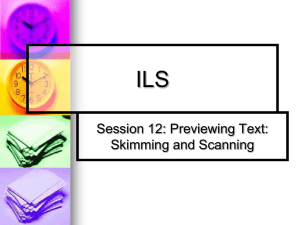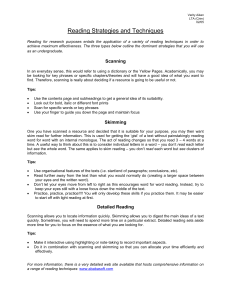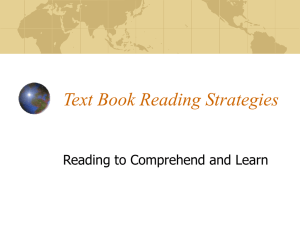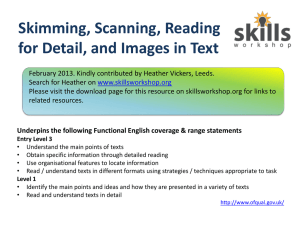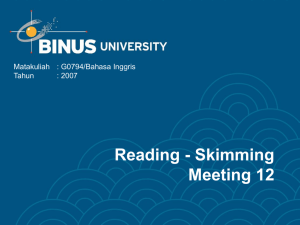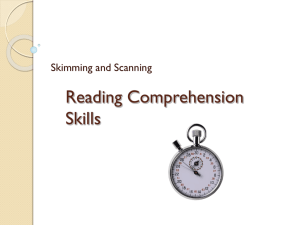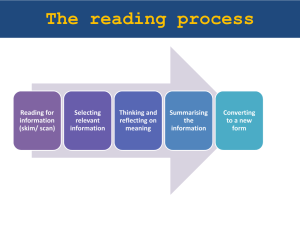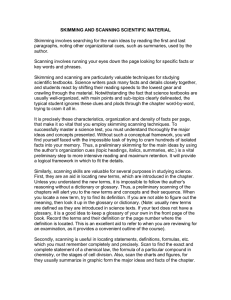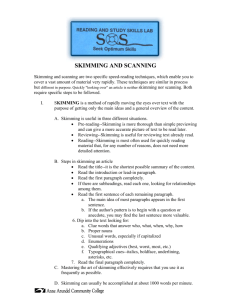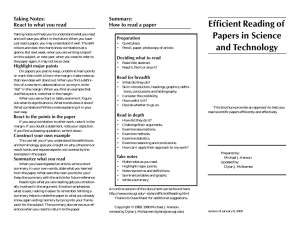ILS - haringeypsychology
advertisement
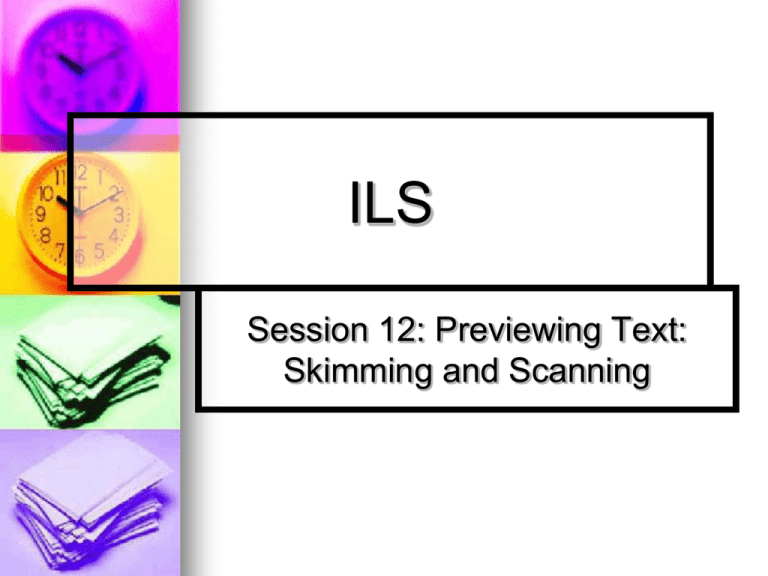
ILS Session 12: Previewing Text: Skimming and Scanning Objectives To understand that reading is a three stage process for the best understanding To apply skimming and scanning techniques To preview texts using I read/I think strategies before beginning writing. Reading task: what is this passage about? If the balloons popped, the sound wouldn’t be able to carry since then everything would be too far away from the correct floor. A closed window would also prevent the sound from carrying since most buildings tend to be well insulated. Since the operation depends on the steady flow of electricity, a break in the middle of the wire would also cause problems. Of course, the fellow could shout but the human voice is not loud enough to carry that far. An additional problem is that the string could break on the instrument. Then there would be no accompaniment to the message. It is clear that the best solution would involve less distance. Then there would be fewer potential problems. With face to face contact, the least number of things could go wrong. Setting the Context If the balloons popped, the sound wouldn’t be able to carry since then everything would be too far away from the correct floor. A closed window would also prevent the sound from carrying since most buildings tend to be well insulated. Since the operation depends on the steady flow of electricity, a break in the middle of the wire would also cause problems. Of course, the fellow could shout but the human voice is not loud enough to carry that far. An additional problem is that the string could break on the instrument. Then there would be no accompaniment to the message. It is clear that the best solution would involve less distance. Then there would be fewer potential problems. With face to face contact, the least number of things could go wrong. Corandic Corandic is an emurient grof with many fribs. It granks from corite, an olg which cargs like lange. Corite grinkles several other tanances, which garkers excarp by glarking the corite and starping it in tranker-clarped strobs. The tarances starp a chark which is expargated with worters,branking a slorp. This slorp is garped through several other corusces, finally frasting a pragety,blickant crankle: coranda. Coranda is a cargurt, grinking corandic and borigen. The corandic is nacerated from the borigen by means of loacacity. Thus garkers finally thrap a glick, bracht, glupous grapant, corandic, which granks with many starps. Corandic questions What is Corandic? How do garkers excarp? What is Coranda? How to we begin reading tasks? Before Reading During After Before you begin reading Look at how the text is organised - what are the headings, subheadings, illustrations and captions telling you about what this text might be about? Look for key terms in the text - annotate next to the text what these mean. Circle any words that you don’t know the meaning of and then re-read the sentence and see if you can work it out. Read the introduction to the text and the conclusion - summarise what you think the text might be about. Bullet point next to the text what you already know about the topic. Begin reading. Skimming technique What is it? When you SKIM, you read quickly to get the main idea of a paragraph, page, chapter or article, and a few (but not all!) of the details. Why do I skim Skimming allows you to read quickly to get a general sense of a text so that you can decide whether it has useful information for you. You may also skim to get a key idea. After skimming a piece of, you might decide hat you want or need to read it in greater depth. How do I skim? 1. 2. 3. Read in this direction. 4. 5. Read the first few paragraphs, two, or three middle paragraphs, and the final two or three paragraphs of a piece, trying to get a basic understanding of the information. Some people prefer to skim by reading the first and last sentence of each paragraph, that is, the topic sentences and concluding sentences. If there are pictures, diagrams or charts, a quick glance at them and their captions may help you to understand the main idea or point of view in the text. Remember: You do not have to read every word when you skim. Generally move your eyes horizontally (and quickly) when you skim Scanning technique What is it? When you SCAN, you move your eyes quickly down a page or list to find one specific detail. Why do I scan Scanning allows you to locate quickly a single fact, date, name or word in a text without trying to read or understand the rest of the piece. You may need that fact or word later to respond to a question or to add a specific detail to something you are writing. How do I scan? 1. 2. 3. Read in this direction. 4. Knowing your text well is important. Make a prediction about where in a chapter you might find the word, name, fact, term, or date. Note how the information is arranged on a page. Will headings, diagrams, or boxed or highlighted items guide you? Is information arranged alphabetically or numerically as it might be in a telephone book or glossary? Move your eyes vertically or diagonally down the page, letting them dart quickly from side to side and keeping in mind that exact type of information that you want. Look for other closely associated words that might steer you towards the detail for which you are looking. Aim for 100% accuracy! One last tip... I read/I think/Therefore As we have seen earlier in the session a great deal of what is read by students (and teachers ) is read but not processed and understood. It is very easy to have a book open and read it for 30 minutes and then realise you couldn’t say a single thing that you have read! I read/I think/Therefore is a strategy that you can use to begin your reading and ensure that you identify the main points and digest what the text is about. This technique can also be done prior to reading proper. Plenary On your post-it, how can what you have learnt in today’s session help you with your wider reading in your subjects? ILS Session 14: Reading strategies 2 Session objectives - - - Try out a range of reading strategies that can be used; To help reading of complex text outside of lessons To help summarise important information inside lessons To help revise for end of year examinations Remember... The last session you had on reading strategies focused on skimming and scanning. THINK-PAIR-SHARE - turn to your partner and explain the process of each one. Have you used these strategies since in your reading? If yes, did it help? If not, why? In groups Each group will be given a new reading strategy to try out. You will be given a set of instructions for how to complete the activity and will then need to prepare a short presentation to feedback to the rest of the students. Your mission is to try and convince them that your strategy is the best strategy ever!!!
